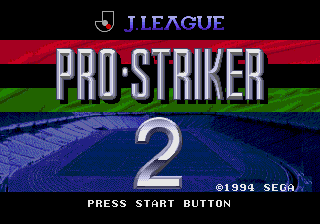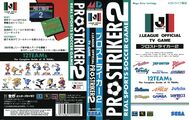Difference between revisions of "J.League Pro Striker 2"
From Sega Retro
m (Text replacement - "publisher=Sega" to "publisher=Sega Enterprises") |
|||
| (36 intermediate revisions by 9 users not shown) | |||
| Line 1: | Line 1: | ||
| − | |||
{{Bob | {{Bob | ||
| bobscreen=JLeagueProStriker2_MDTitleScreen.png | | bobscreen=JLeagueProStriker2_MDTitleScreen.png | ||
| − | | publisher=[[Sega]] | + | | publisher=[[Sega Enterprises, Ltd.|Sega Enterprises]] |
| − | | developer=[[Sega | + | | developer=[[Sega CS3]], [[Sega CS4]] |
| + | | licensor=[[J.League]] | ||
| system=[[Sega Mega Drive]] | | system=[[Sega Mega Drive]] | ||
| − | + | | sounddriver=[[SMPS Z80]] | |
| − | | sounddriver= | ||
| peripherals=[[Team Player]] | | peripherals=[[Team Player]] | ||
| players=1-4 | | players=1-4 | ||
| − | | genre=Sports | + | | genre=Sports{{fileref|JLeagueProStriker2 MD JP Box.jpg}}{{ref|https://web.archive.org/web/20200720095133/https://sega.jp/history/hard/megadrive/software.html}} |
| + | | subgenre=football | ||
| releases={{releasesMD | | releases={{releasesMD | ||
| − | | md_date_jp=1994-07-15 | + | | md_date_jp=1994-07-15{{ref|https://web.archive.org/web/20200720095133/https://sega.jp/history/hard/megadrive/software.html}} |
| md_code_jp=G-5540 | | md_code_jp=G-5540 | ||
| md_rrp_jp=7,800 | | md_rrp_jp=7,800 | ||
| + | | md_date_jp_Jitsuenyou Sample=1994 | ||
}} | }} | ||
| + | | savetype={{SaveType | ||
| + | |MD|battery | ||
}} | }} | ||
| − | '''''{{PAGENAME}}''''' (Jリーグプロストライカー2) is the sequel to the football game ''[[J. League Pro Striker]]'', created by [[Sega]] in 1994 for the [[Sega Mega Drive]]. | + | }} |
| + | {{stub}}'''''{{PAGENAME}}''''' (Jリーグプロストライカー2) is the sequel to the football game ''[[J.League Pro Striker]]'', created by [[Sega]] in 1994 for the [[Sega Mega Drive]]. | ||
==Gameplay== | ==Gameplay== | ||
| − | As the name suggests, '' | + | As the name suggests, ''{{PAGENAME}}'' features teams from the Japanese [[wikipedia:J.League|J.League]], specifically the 12 teams which competed in the 1994 season: |
| − | {{multicol| | + | {{#vardefine:logodate|1994-07-15}}{{multicol| |
| − | *Gamba Osaka | + | *{{FootballLogo|Gamba Osaka}} Gamba Osaka |
| − | *JEF United Ichihara | + | *{{FootballLogo|JEF United Ichihara}} JEF United Ichihara |
| − | *Nagoya Grampus Eight | + | *{{FootballLogo|Nagoya Grampus Eight}} Nagoya Grampus Eight |
| − | *Sanfrecce Hiroshima | + | *{{FootballLogo|Sanfrecce Hiroshima}} Sanfrecce Hiroshima |
| − | *Urawa Red Diamonds | + | *{{FootballLogo|Urawa Red Diamonds}} Urawa Red Diamonds |
| − | *Verdy Kawasaki | + | *{{FootballLogo|Verdy Kawasaki}} Verdy Kawasaki |
| − | *Yokohama Flügels | + | *{{FootballLogo|Yokohama Flügels}} Yokohama Flügels |
| − | *Yokohama Marinos | + | *{{FootballLogo|Yokohama Marinos}} Yokohama Marinos |
| − | *Kashima Antlers | + | *{{FootballLogo|Kashima Antlers}} Kashima Antlers |
| − | *Shimizu S-Pulse | + | *{{FootballLogo|Shimizu S-Pulse}} Shimizu S-Pulse |
| − | *Júbilo Iwata | + | *{{FootballLogo|Júbilo Iwata}} Júbilo Iwata |
| − | *Bellmare Hiratsuka | + | *{{FootballLogo|Bellmare Hiratsuka}} Bellmare Hiratsuka |
}} | }} | ||
| + | |||
| + | ==History== | ||
| + | ===Development=== | ||
| + | Initially, the game was developed by the 1993 iteration of [[Sega CS3]], featuring developers that were concurrently working on the Mega Drive games ''[[Streets of Rage 3]]'' and ''[[OutRunners]]'', all produced by [[Makoto Oshitani]]. However, it was released 3 months after a reorganization of Sega's development departments,{{magref|harmony|128|12}}, which predates the game being revealed to the public,{{magref|bemega|1994-06|84}} so had to be finished by [[Sega CS4]], some of whose members are given special thanks, and with [[Koichi Nagata]] also credited as producer. It also gives special thanks to various members of [[Sega AM1]], at least one of whom, [[Attila Vass]], is known to have worked on ''[[The J.League 1994]]'' which released the same month, suggesting the two teams may have influenced the other's work. | ||
| + | |||
| + | ===Legacy=== | ||
| + | A ROM hack of this game known as ''[[Futbol Argentino 96]]'' was unofficially distributed in South America, similarly to other football games like ''[[International Superstar Soccer Deluxe]]'' which were notorious for being redistributed as localised ROM hacks across the continent, replacing the teams and players with those from Argentina, Brazil, Colombia or Peru. | ||
==Production credits== | ==Production credits== | ||
| − | {{ | + | {{mainArticle|{{PAGENAME}}/Production credits}} |
| − | |||
| − | |||
| − | |||
| − | |||
| − | |||
| − | |||
| − | |||
| − | |||
| − | |||
| − | |||
| − | |||
| − | }} | ||
==Magazine articles== | ==Magazine articles== | ||
{{mainArticle|{{PAGENAME}}/Magazine articles}} | {{mainArticle|{{PAGENAME}}/Magazine articles}} | ||
| + | |||
| + | ==Promotional material== | ||
| + | {{gallery | ||
| + | |{{galleryPrintAd|bemega|1994-07|2}} | ||
| + | |{{galleryPrintAd|bemega|1994-08|140}} | ||
| + | }} | ||
==Physical scans== | ==Physical scans== | ||
| − | {{ratings | + | {{ratings|MD}} |
| − | | | ||
| − | |||
| − | |||
| − | }} | ||
{{Scanbox | {{Scanbox | ||
| console=Mega Drive | | console=Mega Drive | ||
| Line 65: | Line 66: | ||
| cart=JLeagueProStriker2_MD_JP_Cart.jpg | | cart=JLeagueProStriker2_MD_JP_Cart.jpg | ||
| carttop=JLeagueProStriker2_MD_JP_CartTop.jpg | | carttop=JLeagueProStriker2_MD_JP_CartTop.jpg | ||
| + | | manual=JLeagueProStriker2 MD JP Manual.pdf | ||
}}{{Scanbox | }}{{Scanbox | ||
| console=Mega Drive | | console=Mega Drive | ||
| region=JP (Jitsuenyou Sample) | | region=JP (Jitsuenyou Sample) | ||
| + | | cover=JLPS2 MD JP sample cover.jpg | ||
| + | | cart=JLPS2 MD JP sample cart.jpg | ||
}} | }} | ||
==Technical information== | ==Technical information== | ||
| − | + | {{mainArticle|{{PAGENAME}}/Technical information}} | |
| − | {{ | ||
| − | {{ | ||
| − | }} | ||
==References== | ==References== | ||
| − | <references /> | + | <references/> |
| − | {{ | + | {{JLeagueProStriker2Omni}} |
{{JLeague}} | {{JLeague}} | ||
Latest revision as of 17:14, 4 November 2024
| J.League Pro Striker 2 | |||||||||||||||
|---|---|---|---|---|---|---|---|---|---|---|---|---|---|---|---|
| System(s): Sega Mega Drive | |||||||||||||||
| Publisher: Sega Enterprises | |||||||||||||||
| Developer: Sega CS3, Sega CS4 | |||||||||||||||
| Licensor: J.League | |||||||||||||||
| Sound driver: SMPS Z80 | |||||||||||||||
| Peripherals supported: Team Player | |||||||||||||||
| Genre: Sports[1][2] (football) | |||||||||||||||
| Number of players: 1-4 | |||||||||||||||
|
This short article is in need of work. You can help Sega Retro by adding to it.
J.League Pro Striker 2 (Jリーグプロストライカー2) is the sequel to the football game J.League Pro Striker, created by Sega in 1994 for the Sega Mega Drive.
Contents
Gameplay
As the name suggests, J.League Pro Striker 2 features teams from the Japanese J.League, specifically the 12 teams which competed in the 1994 season:
 Gamba Osaka
Gamba Osaka JEF United Ichihara
JEF United Ichihara Nagoya Grampus Eight
Nagoya Grampus Eight Sanfrecce Hiroshima
Sanfrecce Hiroshima Urawa Red Diamonds
Urawa Red Diamonds Verdy Kawasaki
Verdy Kawasaki Yokohama Flügels
Yokohama Flügels Yokohama Marinos
Yokohama Marinos Kashima Antlers
Kashima Antlers Shimizu S-Pulse
Shimizu S-Pulse Júbilo Iwata
Júbilo Iwata Bellmare Hiratsuka
Bellmare Hiratsuka
History
Development
Initially, the game was developed by the 1993 iteration of Sega CS3, featuring developers that were concurrently working on the Mega Drive games Streets of Rage 3 and OutRunners, all produced by Makoto Oshitani. However, it was released 3 months after a reorganization of Sega's development departments,[3], which predates the game being revealed to the public,[4] so had to be finished by Sega CS4, some of whose members are given special thanks, and with Koichi Nagata also credited as producer. It also gives special thanks to various members of Sega AM1, at least one of whom, Attila Vass, is known to have worked on The J.League 1994 which released the same month, suggesting the two teams may have influenced the other's work.
Legacy
A ROM hack of this game known as Futbol Argentino 96 was unofficially distributed in South America, similarly to other football games like International Superstar Soccer Deluxe which were notorious for being redistributed as localised ROM hacks across the continent, replacing the teams and players with those from Argentina, Brazil, Colombia or Peru.
Production credits
- Main article: J.League Pro Striker 2/Production credits.
Magazine articles
- Main article: J.League Pro Striker 2/Magazine articles.
Promotional material
Physical scans
| Sega Retro Average | ||||||||||||||||||||||||||||||||||
|---|---|---|---|---|---|---|---|---|---|---|---|---|---|---|---|---|---|---|---|---|---|---|---|---|---|---|---|---|---|---|---|---|---|---|
|
| 70 | |
|---|---|
| Based on 6 reviews | |
Technical information
- Main article: J.League Pro Striker 2/Technical information.
References
- ↑ File:JLeagueProStriker2 MD JP Box.jpg
- ↑ 2.0 2.1 https://sega.jp/history/hard/megadrive/software.html (Wayback Machine: 2020-07-20 09:51)
- ↑ Harmony, "1994 5-6" (JP; 1994-05-23), page 12
- ↑ Beep! MegaDrive, "June 1994" (JP; 1994-05-07), page 84
- ↑ 1700 igr dlya Sega, "" (RU; 2001-xx-xx), page 241
- ↑ Beep! MegaDrive, "August 1994" (JP; 1994-07-08), page 20
- ↑ Mega Fun, "12/94" (DE; 1994-11-23), page 114
- ↑ Sega Pro, "October 1994" (UK; 1994-09-08), page 62
- ↑ Sega Saturn Magazine, "September 1995" (JP; 1995-08-08), page 85
- ↑ Tricks 16 bit, "Tricks Sega Gold 800 igr" (RU; 1998-03-20), page 92
| J.League Pro Striker 2 | |
|---|---|
|
Main page | Credits | Hidden content | Magazine articles | Reception | Region coding | Technical information | Bootlegs | |
| J.League-sponsored football games for Sega systems | |
|---|---|
| J.League Champion Soccer (1993) | J.League Pro Striker (1993) | J.League Pro Striker Kanzenban (1993) | J.League Pro Striker 2 (1994) | Pro Striker Final Stage (1995) | |
| The J. League 1994 (1994) | |
| J.League GG Pro Striker '94 (1994) | J.League Soccer Dream Eleven (1995) | |
| Victory Goal (1995) | Victory Goal '96 (1996) | J.League Victory Goal '97 (1997) | J.League Go Go Goal! (1997) | J.League Jikkyou Honoo no Striker (1998) | |
| J.League Spectacle Soccer (2002) | |
| See also: Soccer Tsuku | |





